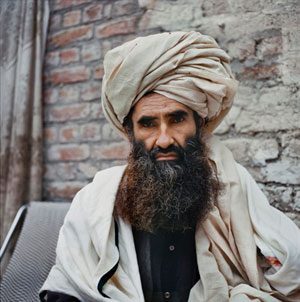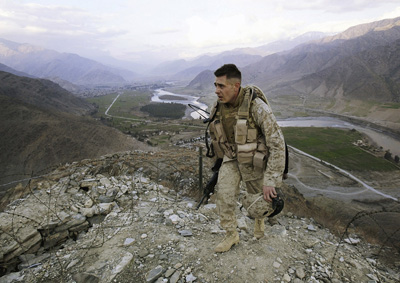
Afghanistan is a complicated, recalcitrant land that has resisted invaders for centuries and that requires patient observation and understanding from those who would like to influence its development. Robert Nickelsberg, a photo-journalist who has covered Afghanistan for over a quarter of a century, showed a selection of his carefully observed pictures from the country dating back to 1988 to LAWAC members on Wednesday - each image showed a different face of a land that few have understood and none have conquered.
Nickelsberg started with images of Soviet troops withdrawing in 1988-89, after the USSR had killed some 1 million Afghans during its decade-long occupation. What follows is bitter civil war between the mujahideen leaders who had jointly fought the Soviets, some murderous shelling in Kabul, and a state of anarchy that only came to an end when the Taliban took the capital in 1996. Nickelsberg has pictures of young soldiers fighting in the streets of Kabul, as scared families took refuge from the fighting behind mud-brick walls - a routine that has been repeated many times in three decades of war.

The images alternated between rugged fighters in an even more rugged mountainous terrain and helpless civilians fleeing the fighting with their most prized possessions - a bicycle, a chicken, a bag of dry food and a teacup... After the US expelled the Taliban in 2001 following 9/11, Nickelsberg has pictures of Arab al Qaeda fighters captured in the caves of Tora Bora where they have been hiding for days from the US bombing, their eyes still full of the terror of listening to 500 lb bombs exploding at the entrances to their caves.
US Marines struggle up sheer mountainsides with 50-pound packs on their shoulders, Taliban fighters in plastic sandals and no body armor fire missiles at their enemies, and a dead Taliban acquires blue finger tips as a US forensic team come and check his finger prints. The mixed population of Uzbeks, Tajiks, Ismailis, Hazara and Pashtun with their distinctive faces and accumulated mutual suspicion - all have deep penetrating eyes, the famous Afghan stare that has bewitched so many photographers.

By contrast the US soldiers look unsure of themselves and out of place - confident in their equipment, but completely unschooled in the local way of life. Even when they smile at the local people, they often don’t have any words to follow in the local language. And so as we contemplate how many - or few - of our troops to leave behind in Afghanistan after this year’s withdrawal, we are still dealing with a country that we barely understand, a country where we closed our embassy in 1990 and remained absent until 2001.
“Don’t leave,” Nickelsberg advised, when asked if US troops should all be pulled out of Afghanistan this year. “Stay there and don’t be so risk averse. Study the place and put your best people there.” That is what the Russians and the Iranians are doing, not to mention the Pakistanis and the Indians: our rivals for influence, yet again, with a people who are now desperate for peace.
